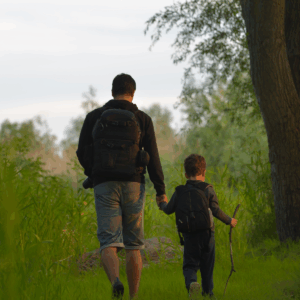Feeling calm in a storm isn’t just a nice personality trait. I believe it’s a parenting strategy.
Over the years (first as a dad, now as a granddad who gets most of his exercise chasing scooters), I’ve noticed a pattern: when parents prize peace over perfection, kids stand a little taller.
They speak up more. They recover faster when life knocks them around.
That isn’t about letting everything slide. It’s about the tone you set at home—less pressure, more presence.
On Artful Parent, we talk a lot about raising sturdy, kind humans. From what I’ve seen (and lived), an atmosphere of calm, respectful consistency is rocket fuel for confidence.
Here’s how I think about it.
1) Choose the connection before correction
Ever try to “teach a lesson” while your child is still heated?
It’s like trying to fold a hot pizza – mess everywhere. When emotions are spiking, prioritizing peace looks like co‑regulation first, coaching later.
I’ll sit on the edge of the bed and say, “I’m here. Take your time.” We breathe for a minute.
Once the nervous system quiets down (mine included) I ask, “Want comfort, a sounding board, or ideas?”
Nine times out of ten, they pick comfort or a sounding board. After that, they’re ready to problem-solve.
Related Stories from The Artful Parent
Kids remember how you made them feel in the hard moments. Connection says, “You’re safe with me,” and safety grows confidence from the inside out.
2) Build “good‑enough” routines, not perfect schedules
I like a tidy plan as much as the next person. But family life is jazz, not a symphony – lots of improv. Pursuing perfect routines often ends with everyone tense and nobody sleeping well. Pursuing “good enough” keeps the train moving.
- A predictable bedtime window instead of a minute‑exact rule.
- A “most days” movement habit (twenty minutes of walking, shooting hoops, dancing in the kitchen).
- A simple dinner rhythm: one veg, one protein, one grain. Done.
Good‑enough routines reduce friction. Less friction means fewer battles.
Fewer battles mean your child spends more time succeeding than apologizing – and that’s a confidence loop worth repeating.
3) Model self‑compassion out loud
Kids treat themselves the way we treat ourselves, especially when they fail. If they hear you mutter, “I’m such an idiot,” that becomes permission to trash their own effort.
When you miss the mark and respond with kindness, you hand them a different script.
- You know a man is struggling with unhappiness when he stops caring about these 9 things - Global English Editing
- 10 of the most comforting dog breeds for people with anxious personalities - Global English Editing
- People who age slowly and maintain their energy usually practice these 9 daily rituals - Global English Editing
I’ll say, “I blew that. I’m disappointed, and I’m allowed to learn.” It’s not a performance; it’s a tone.
And it pairs well with something I’ve mentioned before: Rudá Iandê’s new book, Laughing in the Face of Chaos. As he writes, “When we let go of the need to be perfect, we free ourselves to live fully—embracing the mess, complexity, and richness of a life that’s delightfully real.”
The book inspired me to speak to myself the way I want my grandkids to speak to themselves – fewer insults, more curiosity. Funny thing: the more self‑compassion I practice, the braver the kids get about trying new things.
4) Praise the process, not just the prize
Perfection chases gold stars. Peace notices effort. When I comment on how my granddaughter stuck with a tough paragraph or how my grandson handled a frustrating drill, I’m telling them their effort matters.
Confidence grows when the scoreboard isn’t the only source of approval.
- Instead of “You’re so smart,” try “You figured out a new strategy.”
- Instead of “I’m proud of the A,” try “I’m proud of how you broke the project into steps.”
- Instead of “You’re a natural,” try “You practiced until it clicked.”
Praising the process turns setbacks into feedback. That alone makes kids bolder.
5) Keep consequences calm, clear, and boring
Peace isn’t permissive. Boundaries still matter; they’re just delivered without theatrics. I think of it as “warm tone, firm line.”
If a curfew is missed, we move the next curfew earlier. I don’t give a fifteen‑minute speech or invent a creative punishment.
I say, “We need to rebuild trust. Tomorrow’s curfew is 9:30. We’ll reassess next weekend.” No sarcasm, no shaming. Just cause and effect.
Kids trust what’s predictable. Predictability is steady ground to stand on. And steady ground is where confident choices come from.
6) Repair quickly and teach the apology script
Perfection says, “Don’t mess up.” Peace says, “When we do—and we will—we fix it.” I’ve watched repair change the entire atmosphere of a home.
Here’s the simple script I use (and teach):
- Name the impact: “I interrupted you and it felt dismissive.”
- Own it: “That was wrong.”
- Apologize: “I’m sorry.”
- Offer a path: “Want to try that conversation again now or after dinner?”
No “but you…” add‑ons. No courtroom. Just a reset.
Over time, kids internalize that mistakes don’t end relationships—they’re invitations to practice integrity.
That shifts them from defensiveness to responsibility, which is where real confidence lives.
7) Protect low‑conflict communication
Perfectionism sneaks into our voices: the constant corrections, the heavy sighs, the “After all I do for you…” lines that guilt kids into obedience. Peaceful communication is simple and direct.
- Ask permission to coach: “Open to a suggestion or want me to zip it?”
- Use “when/then” expectations: “When your homework’s done, then the Xbox comes on.”
- Drop the sarcasm: it’s just anger in a clown suit.
- Set a daily “no nag” zone: a protected pocket of time—bedtime chat, a short walk—where nothing gets corrected.
When home becomes a low‑conflict zone, kids take more risks with you, not away from you. That partnership builds durable self‑belief.
8) Leave space for play, rest, and boredom
Perfection fills every minute with “enrichment.” Peace leaves white space. Confidence is built as much on recovery as on reps.
- One screen‑light evening a week (board games, music, drawing, or just flopping on the floor with the dog).
- Unscheduled hours on weekends. Boredom is the doorway to self‑directed creativity.
- Ten minutes of no‑agenda connection: “Tell me something good, something hard, something funny.”
It doesn’t look impressive on Instagram. It looks like a life. And a kid who knows how to rest, play, and self‑start will walk into adulthood feeling capable, not constantly behind.
Final thoughts
I took up writing after retiring from an office job. I learned the hard way that most of my own stress came from trying to be the perfect dad instead of the present one.
When I traded performance for presence, everything got warmer – conversations, routines, even the way the dog looked at me.
If you’d like a companion for that same shift, I can’t recommend Rudá Iandê’s new release enough: Laughing in the Face of Chaos. He has a knack for inviting you out of the performance trap and back into real relationship with yourself and your family.
My insights from the book nudged me to choose the calmer road more often—and I’ve watched the kids’ confidence rise to meet it.
Peace over perfection isn’t soft. It’s sturdy. It’s a choice to build a home where mistakes are teachers, emotions are welcome, and love doesn’t hinge on a score. That’s the kind of soil where confident adults grow.
Which small shift toward peace are you willing to make this week?



